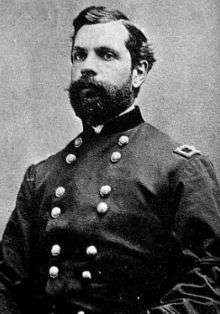Charles Doolittle
| Charles Camp Doolittle | |
|---|---|
 Charles Camp Doolittle | |
| Born |
March 16, 1832 Burlington, Vermont |
| Died |
February 20, 1903 (aged 70) Toledo, Ohio |
| Place of burial | Woodlawn Cemetery, Toledo, Ohio |
| Allegiance |
United States of America Union |
| Service/branch |
United States Army Union Army |
| Years of service | 1861 - 1865 |
| Rank |
|
| Battles/wars | American Civil War |
Charles Camp Doolittle (March 16, 1832 – February 20, 1903) was a store clerk, general in the Union Army during the American Civil War, and a bank cashier.
Biography
Doolittle was born in Burlington, Vermont, the son of Matthew Doolittle. He attended school in Montreal, Quebec, and moved to New York City in 1847, finally settling in Hillsdale, Michigan, where he was a store clerk.
He was commissioned first lieutenant in Company E, 4th Michigan Infantry on June 20, 1861, and promoted to captain of Company H on August 20, 1861. His regiment participated in the Peninsula Campaign, where he was wounded at the Battle of Gaines' Mill on June 28, 1862. He was promoted to colonel and assumed command of the 18th Michigan Infantry on August 13, 1862. Doolittle and his regiment served in the Western Theater for the duration of the war, with various assignments in Kentucky, Tennessee, Alabama, and Georgia. His troops helped defend Athens, Alabama, against Confederate cavalry under Joseph Wheeler and Decatur, Alabama, against John Bell Hood.
On April 22, 1865, President Andrew Johnson appointed Doolittle brigadier general of volunteers to rank from January 27, 1865.[1] President Abraham Lincoln had nominated Doolittle for the appointment on January 30, 1865 and the U.S. Senate confirmed the nomination on February 14, 1865 but Lincoln was unable to make the formal appointment before he was assassinated.[1] Doolittle was mustered out of the volunteer service on November 30, 1865.[1] On February 24, 1866, President Johnson nominated Doolittle for appointment to the brevet grade of major general of volunteers, to rank from March 13, 1865, and the U.S. Senate confirmed the appointment on May 4, 1866.[2]
After the war he was a cashier at Merchant's National Bank in Toledo, Ohio. He is buried in Toledo's Woodlawn Cemetery.
See also
Notes
- 1 2 3 Eicher, John H., and David J. Eicher, Civil War High Commands. Stanford: Stanford University Press, 2001. ISBN 0-8047-3641-3. p. 720
- ↑ Eicher, 2001, p. 711
References
- Boatner, Mark M., The Civil War Dictionary. New York: David McKay Co., 1959.
- Eicher, John H., and David J. Eicher, Civil War High Commands. Stanford: Stanford University Press, 2001. ISBN 0-8047-3641-3.
- Johnson, Rossiter, ed., Twentieth Century Biographical Dictionary of Notable Americans. Volumes I-X. Boston, MA: The Biographical Society, 1904.
- Sifakis, Stewart, Who Was Who in the Union. New York: Facts on File, Inc., 1988.
- Warner, Ezra, Generals In Blue. Louisiana State University Press, 1964.